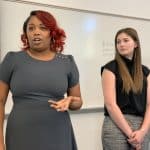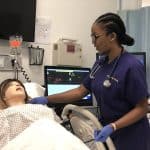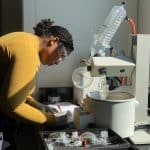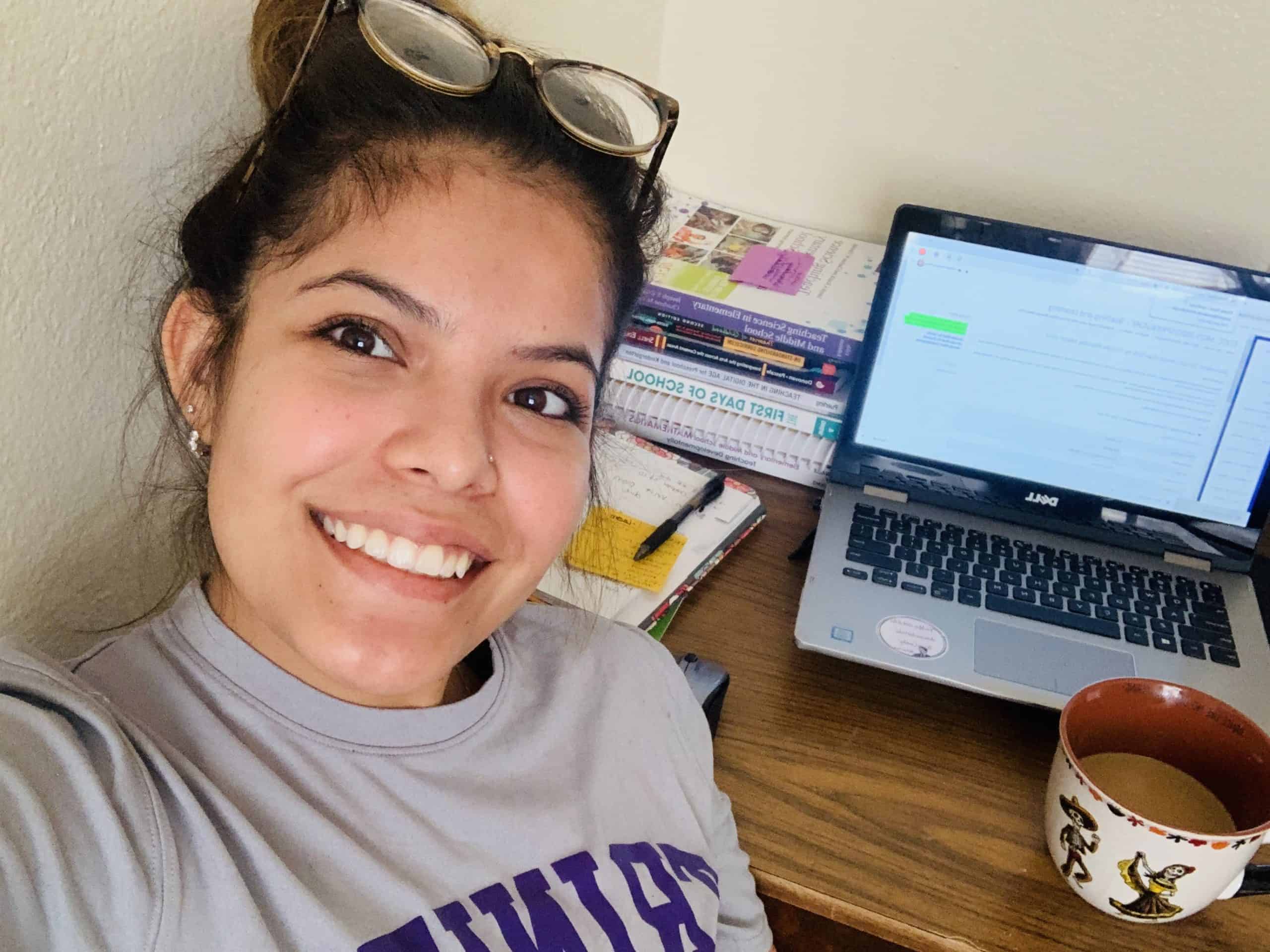
2020: Crisis, Response, Renaissance – President’s Report
PRESIDENT PATRICIA MCGUIRE

Spring 2020 was a time of dramatic change, from a quick pivot to remote learning to virtual Commencement celebrations via Zoom.
When I first drafted this President’s Report in late 2019, we planned to publish the TRINITY magazine in mid-Spring 2020 and so we organized our line-up of features and news accordingly.
Then, to the sorrow of all in the Trinity family, our beloved President Emerita Sister Margaret Claydon ’45, SND, died on February 1, 2020. As tributes poured in and we prepared to celebrate her amazing life and achievements, we pushed aside the earlier story line-up and prepared to publish this memorial edition of TRINITY.
And then… Pandemic. Vague news reports of a new virus afflicting various countries coalesced and exploded into a fullblown global pandemic in early March. Covid-19 suddenly caused all prior plans to vanish, replaced with hurried, sometimes frantic, new plans and tactics lifting up the urgency of health and safety above all other considerations. Publishing a magazine became impossible as we closed campus operations and scrambled to move courses and all work online.
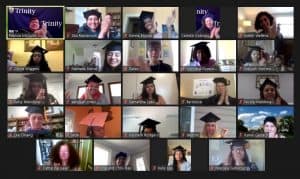 We worked through the summer to prepare Trinity for a multidimensional “reopening” for Fall 2020, described in more detail below. I am pleased that we are now able to publish this longdelayed edition of the TRINITY magazine with our special tribute to Sister Margaret. Through these long months, I often found myself asking, “What would Margaret do?” I could feel her spirit urging us on through the difficult days and hard choices, reminding me that she also faced many challenges that she surmounted with resilience, wisdom and the grace to accept necessary changes.
We worked through the summer to prepare Trinity for a multidimensional “reopening” for Fall 2020, described in more detail below. I am pleased that we are now able to publish this longdelayed edition of the TRINITY magazine with our special tribute to Sister Margaret. Through these long months, I often found myself asking, “What would Margaret do?” I could feel her spirit urging us on through the difficult days and hard choices, reminding me that she also faced many challenges that she surmounted with resilience, wisdom and the grace to accept necessary changes.
Sister Margaret’s legacy is clear as we open this new chapter in Trinity’s life, finding new ways to achieve our timeless mission, always devoted to the ideals of academic excellence, honor and service to others in social justice, the tangible expressions of the “power, wisdom and love of the Most Holy Trinity.”
I offer this 2020 President’s Report with great confidence in Trinity’s future, working through the current pandemic conditions to plan a true renaissance that will carry alma mater forward stronger and bolder than ever before.
President Patricia McGuire ’74
Pandemic Primer: March through August 2020
Light was fading in the early evening on the Garden State Parkway when my phone rang as I was driving to Boston for a meeting. The date was March 9, 2020. Normally I ignore calls while driving, but I saw a “202” number and worried that something might be happening back at Trinity that required my attention. I answered the call while finding a spot to pull over.
“Hello, Pat,” said an unfamiliar voice but quickly identified as a fellow university president in Washington. “I’m calling to let you know that we’ll be closing our campus tomorrow, and I urge you to consider doing the same for Trinity.” My caller explained that the growing problem of the coronavirus pandemic was going to force colleges to close all over the country.
I was stunned. I was certainly aware of the pandemic – I chose to drive to the meeting in Boston in order to avoid the potential coronavirus dangers in air travel. And that very morning before I left Washington, we had a senior staff meeting in which we discussed our detailed plans to manage the campus to keep everyone safe. Spring break had just started, but the thought that our students who had gone home for the break would not return for the balance of the semester seemed preposterous. I sent a message to senior colleagues advising them of what I had just learned from my fellow president and drove on to my meetings.
But the college closure news was breaking rapidly across the country. Quickly returning to Washington while consulting my colleagues all along the way, on Thursday, March 12, I announced that Trinity would move to fully remote instruction – initially, two weeks, but then for the remainder of the Spring semester. I will be forever grateful for the incredibly fast, smart, effective response of the faculty and staff of Trinity, and especially our leaders in Academic and Student Affairs: Provost Carlota Ocampo; Deans Sita Ramamurti, Mary Romanello and Peggy Lewis; Associate Provost Debbie Van Camp; and Vice President Karen Gerlach and Dean Michele Bowie.
As we worked through the balance of the Spring 2020 semester remotely, we surveyed the faculty and students several times, and their input and observations were crucial as we began to lay plans for the Fall 2020 semester. Among many issues, we kept three big concerns front and center:
- First, everyone needs continuous assurance about staying healthy and avoiding coronavirus infection; hence, any plans for “reopening” must have aggressive steps for health and safety including mitigation of potential exposure to Covid-19.
- Second, our plans had to consider the economic consequences of the pandemic on students, faculty and staff – loss of employment for some, loss of family income for others, or worries about losing Spring 2020 was a time of dramatic change, from a quick pivot to remote learning to virtual Commencement celebrations via Zoom. 4 jobs later; our plans had to find a way to provide aid to those with acute needs and to reassure others that we would take care of them.
- Third, Trinity’s experience with online teaching and learning was modest at best, and the early surveys indicated that we had to do better to make sure that students were getting a sound academic experience; our plans had to include developing faculty and student capacity for online learning.
In May, D.C. Mayor Muriel Bowser invited me to participate on the “Reopen DC” advisory group for education, and that experience gave me many insights into how to develop Trinity’s plan for the fall in relation to the expectations of our city. Every university in D.C. had to create a plan addressing whether and how we would reopen our campus, how we would keep everyone safe, and plans for any outbreak of Covid-19 on campus.
Reopening Trinity for Fall 2020
Trinity was the first university in D.C. to file a reopening plan, and we were also the first to have our plan approved. The key elements of Trinity’s reopening plan include:
- We promulgated and are enforcing “Essential Expectations” for everyone on campus as we reopen, including mandatory masks, social distance, handwashing and hygiene, limited group gatherings and other rules based on CDC guidance and D.C. mayor’s orders.
- To reduce campus density, most courses are online for the fall, with just about 9% offered fully face-to-face, 22% hybrid, the balance online:
- Courses in the College of Arts and Sciences are a mix of face-to-face hybrid and online formats, with no more than ten students in any classroom for the face-to-face courses, everyone socially distanced and wearing masks, classrooms sanitized between sessions.
- Courses in the School of Nursing and Health Professions include online instruction for most didactic learning with simulation and other lab sessions face-to-face with appropriate safety precautions; clinical placements are up to each provider partner, with many returning to “live” clinical this fall.
- Courses in the School of Professional and Graduate Studies are all online.
- Resident students returning to campus with one student per room and all appropriate safety protocols in place.
- Faculty spent the summer doing intensive professional development to enlarge their capacity to teach in online and hybrid formats
- Teleworking continues for staff with some rotational shifts in offices and the library to have services available “live” on campus but most delivered online.
Thanks to the CARES Act and some very generous benefactors, we have been able so far to provide extra financial assistance to nearly 900 students in need, about $1.2 million since April. Students who have lost their jobs need money for rent, food and basic living expenses; we do not know if there will be another federal grant to help with the fall semester. With the CARES Act, we were also able to provide laptops to several hundred students who did not have their own computers, but internet access remains challenging for many in their homes and neighborhoods.
We also received a PPP loan (Payroll Protection Program) that made it possible for Trinity to keep all faculty and staff on the payroll with no layoffs or furloughs, especially important since we lost a good deal of revenue during the summer because we could not conduct the conference programs that normally augment our budget. We have reduced expenses as much as possible and our traditional habits of frugality are serving Trinity well during this crisis.
Finally, and most important, we have made it through the last six months with everyone safe and healthy. Within the entire campus community, we have had no cases of coronavirus transmission on campus; among students, faculty and staff, very few have reported positive tests since March, and all of those occurred off-campus and all have recovered. We are vigilant about asking everyone to check for symptoms each day. Trinity’s Director of Health Services Dr. Jacqueline Newsome-Williams has also done heroic work staying in touch with the D.C. Department of Health, responding to many health needs and administering Covid-19 tests. With strong staff work and everyone’s cooperation, we are confident that we will have a safe fall semester.
After Crisis, A Renaissance: Trinity at 125
History reveals that many eras of darkness and crises are followed by times of growth and powerful change, a true renaissance. As we approach Trinity’s 125th Anniversary, our plans for Trinity’s future leverage what we have learned in this very challenging era to create a stronger, more resilient and creative university to serve future generations.
There’s no “going back” after the Covid-19 pandemic. We will not simply resume life as it was in the “time before” either at Trinity, or in higher education, or in the larger society. In April, as we pivoted to remote instruction and telework, I asked our senior staff to address three questions for Trinity’s future:
- What have we learned from this crisis period?
- What will we leave behind when this is over?
- What will we take forward to shape a true renaissance era for Trinity?
As the answers to those questions continue to evolve through the summer and into the fall of 2020, we have been revising Trinity’s Strategic Plan Leading Trinity 2025 to incorporate the best of what we have learned and what we want to take forward. Trinity continues to be the leading women’s university in Washington, and our commitment to our undergraduate women’s college remains as strong as ever. At the same time, we are growing in professional and graduate programs for women and men of all ages and backgrounds, and our pandemic-driven pivot to online instruction is opening new markets for the future, a welcome opportunity to build enrollment and strengthen the overall reputation and fiscal foundation of the university through innovative new programs delivered in new ways.
Among many strategic topics, these four are vitally important to Trinity’s future:
1. Online instruction is permanent
Trinity has learned that we can do online teaching and learning quite successfully. Faculty eagerly embraced professional development programming this summer to develop their capacity to teach online well and creatively, and students for the most part responded favorably, especially in our graduate and professional programs. We are already seeing an increase in enrollment of students who want only online courses, and we believe this will become a larger trend in certain professional programs going forward.
Does this mean that Trinity will abandon classrooms and faceto-face instruction? Absolutely not! Many students still need “live” instruction and many faculty continue to prefer seeing their students regularly. But the embrace of online pedagogy means that Trinity is joining mainstream universities in widening the delivery formats through which students can have access to our educational programs, thus broadening the reach of Trinity’s mission in the world.
2. New credentials and programs for the post-pandemic world
Along with new delivery formats, the pandemic has hastened the discussion throughout higher education about broadening the types of credentials a student can earn as well as program offerings. “Stackable certificates” are among the new credentials that offer students the advantages of earning a credential after mastering a certain amount of focused learning while also building a credit bank toward a degree if desired.
For example, as part of helping child-care workers get credentials now required under D.C. law, Trinity now offers a postsecondary certificate in child development with credits that can be applied to a subsequent associate’s degree in early childhood education. And teachers who already have master’s degrees can earn a certificate in special education with credits applicable to a full master’s degree in that subject.
Trinity is developing additional certificate programs aligned with workforce needs in the Washington region including TESOL (teaching English for speakers of other languages) for educators, community health and public relations.
The pandemic has also heightened attention on the importance of information technology and digital communications in modern life. As part of strategic program development, Trinity is creating concentrations and credentials in data analytics and information technology in keeping with the growing presence of technology companies and large workforce needs in the Washington region.
Beyond all other fields of study and endeavor, the pandemic has focused academic attention on the critical need to develop even more capacity to educate the healthcare workforce. Trinity’s nursing 2020 PRESIDENT’S REPORT 6 program continues to grow in size and stature in the Washington region, and the master’s in occupational therapy is booming. A new master’s in public health has launched with a large enrollment that is likely to grow in the coming years.
Finally, enlarged online educational resources also raise the opportunity for Trinity to offer more continuing education courses and enrichment classes for alumnae and alumni, a topic that was popular in the survey of Trinity graduates we conducted in Fall 2019. We will be communicating more about these opportunities in the months ahead.
3. Reinventing convening and communications
In the last few months, we’ve all learned how to “zoom” – simple phone calls seem almost obsolete as now we gather around screens to meet, follow-up or just catch up. The pandemic has forced us into physical isolation but in a strange way has brought many closer together through the power of technology. I predict that the future will have many fewer “live” meetings as we adapt to meeting on screens. Yes, we definitely need to see each other from time to time, but the savings in time and expense by not having so many meetings in different locations is likely to make this trend a permanent fixture in work life at least.
Postponing large gatherings like Trinity Commencement and Reunion is a sad consequence of the pandemic, but the moment also now forces some overdue rethinking of these kinds of large events and how to create them in more meaningful ways in the future. For example, after conducting twelve different “virtual” commencements for students clustered by major, we discovered that the smaller and more intimate groups were very appealing for students and families because everyone had a chance to speak about the meaning of graduation; in some cases we had family members from all over the world gathered on Zoom to celebrate with their student. While we certainly want to resume the public ceremony of commencement in the future, we will work on finding ways to retain the meaningful personal sharing that occurs best in smaller gatherings.
For our alumnae and alumni, although we did not conduct a virtual Trinity Reunion this year, we know that many classes are gathering online. We are contemplating a substantial overhaul of the Trinity Reunion program to give more time and attention to individual classes and affinity groups throughout the year. Additionally, since social media provides a greater opportunity than ever before for classmates and friends to stay in touch, we are assessing the future communication strategies for print as well as online communications.
4. Re-imagining infrastructure
Just prior to March 2020, the architects at QuinnEvans completed their work on a concept design for the renovation of Alumnae Hall. We commissioned this project as a prelude to launching Trinity’s 125th anniversary capital campaign. The work on the concept design told us that the price tag could be as high as $50 million.
 In the six months since, the pandemic has forced us to do some serious rethinking of our campus, facilities and technology for an academic world that may well be quite different in the future. Alumnae Hall and our other venerable buildings remain in acute need of modernizing, but we also need to re-imagine some of the spaces for new purposes. In the case of Alumnae Hall, for example, we need to re-imagine that beautiful building as a true campus center for all students, faculty, staff and visitors on campus for many different kinds of activities, not just a residence hall with dining facilities. Re-imagining our historic facilities also demands that we address new expectations about sustainable energy practices and cleaner air management systems, a herculean task when we contemplate Main Hall. We need to rethink how much residential capacity Trinity will need in the future, and whether to replace existing residence halls with new structures that allow for new ways of living on the campus among students who will be more likely to expect single rooms, private baths and apartment-style living than sharing rooms and bathrooms in the outmoded dormitory style of the past.
In the six months since, the pandemic has forced us to do some serious rethinking of our campus, facilities and technology for an academic world that may well be quite different in the future. Alumnae Hall and our other venerable buildings remain in acute need of modernizing, but we also need to re-imagine some of the spaces for new purposes. In the case of Alumnae Hall, for example, we need to re-imagine that beautiful building as a true campus center for all students, faculty, staff and visitors on campus for many different kinds of activities, not just a residence hall with dining facilities. Re-imagining our historic facilities also demands that we address new expectations about sustainable energy practices and cleaner air management systems, a herculean task when we contemplate Main Hall. We need to rethink how much residential capacity Trinity will need in the future, and whether to replace existing residence halls with new structures that allow for new ways of living on the campus among students who will be more likely to expect single rooms, private baths and apartment-style living than sharing rooms and bathrooms in the outmoded dormitory style of the past.
While considering the physical architecture, we are also continuously upgrading the technological architecture. Fortunately, Trinity has a remarkable technology leader in our Chief Technology Officer Michael Burback. Mr. Burback and his team have kept all of Trinity’s systems up and running superbly even as we pivoted to the remote teaching and work environment. A strong and well-managed technology infrastructure is the backbone of our ability to operate online, and the next phase of strategic planning will continue to emphasize enlarging and strengthening Trinity’s technological infrastructure.
A Different Epidemic: Racial Injustice
Coronavirus is not the only sickness afflicting American society this year. A fire long smoldering in America’s soul erupted once again in 2020, exposing the deep racism in American society that oppresses African Americans and all persons of color. The deaths of George Floyd, Breonna Taylor and other Black persons at the hands of police have triggered protests across the country, and the Black Lives Matter movement has grown in size and intensity in reaction to the emergence of virulent white supremacy in some places.
With a mission rooted in the Catholic faith teachings on social justice, serving a large majority of Black and Latina students, Trinity is compelled to respond clearly and effectively to the urgent demands for improved racial and social equity for persons of color. Chronic racial injustice limits opportunities for equitable enjoyment of social goods across all sectors of community life: education, healthcare, employment, housing, economic development, participation in political processes and voting. The coronavirus pandemic has had a disproportionately harmful impact on Black and Latina communities, revealing profound inequities in healthcare. The ongoing virulent scourge of white supremacy, emboldened by current politics, brutalizes Black persons and encourages open expressions of racial hatred. Governmental policies and practices targeting immigrants and refugees for harsh and inhumane treatment expose official animus toward persons based on skin color, ethnicity, religion, language and culture.
As we plan for the university’s future, Trinity’s strategic plan for 2025 includes specific strategies and tactics to promote racial equity both on campus and within the larger community. We are calling this initiative Trinity DARE: Driving Actions for Racial Equity.
Trinity DARE: Driving Actions for Racial Equity
Many academic institutions are launching projects this fall that emphasize research and colloquia on racism and anti-racist education. At Trinity, we believe that our students need more than more research and dialogue; the majority of women of color who attend Trinity need opportunities to enter professions on pathways that will propel them into positions of influence and responsibility for decision-making. We believe our students need actions to achieve racial equity, not just more talk. Hence, Trinity DARE has these specific action goals:
- Widening Career Pipelines: Trinity DARE aims to ensure that Trinity graduates have the academic, intellectual and personal preparation necessary to enter professions and advance into leadership positions where persons of color are under-represented in decision-making positions.
- Broadening Access and Ensuring Success: Black women carry the highest student loan debt in the nation, and this burden constrains their long-term economic security and often forces students to leave college before completing degrees. Trinity DARE seeks significant funding to make it possible for Trinity to replace loans with grants for high achieving juniors and seniors.
- Inclusive Excellence Pedagogy and Practices: Building upon the success of the HHMI (Howard Hughes Medical Institute) inclusive excellence program in the sciences, Trinity DARE seeks to broaden inclusive excellence in pedagogy and curriculum development across all disciplines and degree levels.
- Research and Education: Trinity DARE will support specific research projects of faculty and students that focus on the causes and impacts of racial inequity, and offering specific tactical solutions shared through publications, colloquia and other educational activities.
- Trinity Self-Examination and Change: Trinity DARE will include examination of Trinity’s history and current context for promotion of racial equity in all areas of institutional life.
Trinity at 125: Supporting the Renaissance
The Covid-19 pandemic has exposed many vulnerabilities in our society at large and in higher education particularly. Many universities are now suffering grave financial setbacks, and the future for some institutions is perilous. Countercultural as always, Trinity is weathering the difficult economic conditions fairly well, largely because our cost structure has always been modest. Our long habits of frugality, taught to us well by the Sisters of Notre Dame de Namur, meant that we did not have the kinds of expensive amenities that other universities now must sacrifice to stay afloat.
However, while we manage Trinity well with scarce resources, our thin margins mean that we have little investment capital for innovation. As this report indicates, the current historic moment will require much creative change in order for the university to thrive in the future.
Trinity’s 125th Capital Campaign will include a number of priorities with a total goal of $50 million. I am so deeply grateful to a group of tremendous benefactors who have already come together with early gifts to create what we are calling the Renaissance Fund, unrestricted gifts to leverage Trinity’s ability to move through and past the pandemic successfully. We aim to raise a total of $25 million for the Renaissance Fund which, as of this writing, is just over $16 million. Thank you to all benefactors who have come in with early gifts!
In addition to the Renaissance Fund, we are now seeking support for the Trinity DARE project, particularly corporate and foundation gifts to enlarge scholarship resources, strengthen internship and mentor opportunities, and fund faculty and student research. We seek a minimum of $5 million for Trinity DARE.
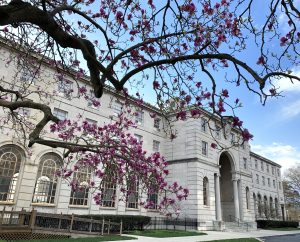 Finally, the Alumnae Hall project will go forward as we re-imagine that building, and we will need a minimum of $25 million to support that renovation.
Finally, the Alumnae Hall project will go forward as we re-imagine that building, and we will need a minimum of $25 million to support that renovation.
By the end of the Year 2025, I have every confidence that Trinity will have realized much success in this endeavor to raise considerable capital to support this remarkable university entering the middle of the 21st Century. As our Founder Sr. Mary Euphrasia Taylor wrote in 1897, imploring her colleague Sr. Julia McGroarty to agree to a fund raising campaign to start Trinity, “The project is so grand, the incentives so great… We shall succeed!”
